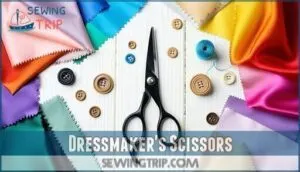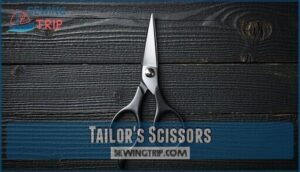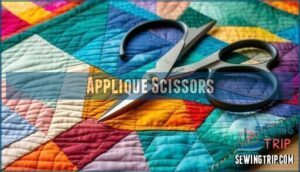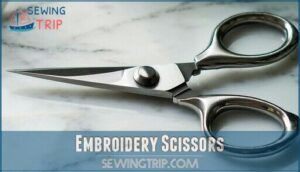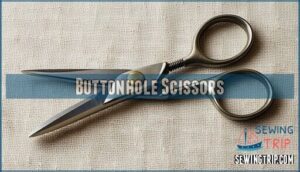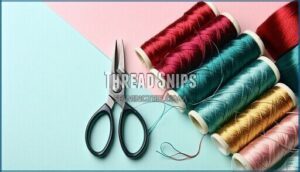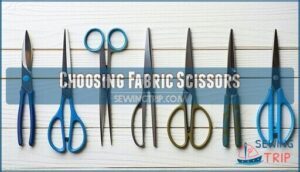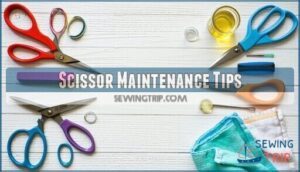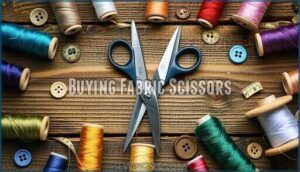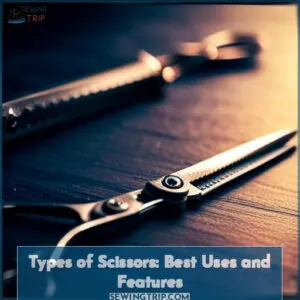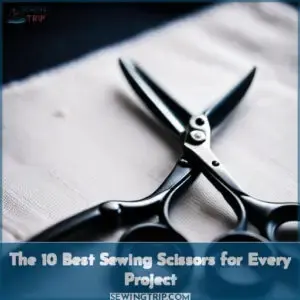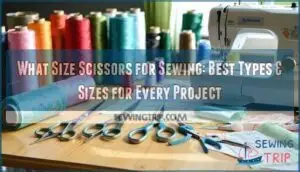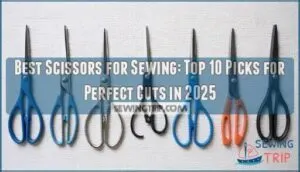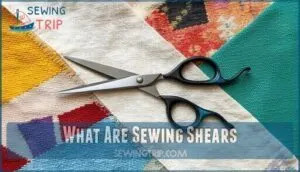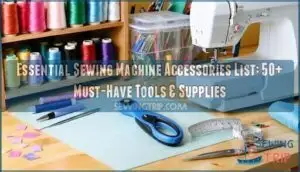This site is supported by our readers. We may earn a commission, at no cost to you, if you purchase through links.
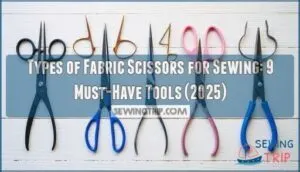
Dressmaker’s shears are your workhorses for cutting long, straight lines through most fabrics. Embroidery scissors tackle detailed work with their sharp, pointed tips. Appliqué scissors feature a unique paddle design that protects lower fabric layers while trimming upper ones.
Pinking shears create zigzag edges that prevent fraying. Thread snips quickly cut threads and small details. Buttonhole scissors make precise openings.
Tailor’s scissors handle heavy fabrics like wool and canvas. Each type serves specific purposes, from delicate silk to sturdy denim. The right scissor makes clean cuts without fraying, while the wrong one can ruin expensive fabric.
Smart sewers know that different projects demand different tools, and using the right tool is crucial for achieving professional-looking results with minimal effort and maximum precision.
Table Of Contents
- Key Takeaways
- Fabric Scissors Basics
- Types of Fabric Scissors
- Specialized Scissors
- Top 9 Fabric Scissors
- 1. Gingher 8 Inch Dressmaker Fabric Scissors
- 2. Amazon Basics Multipurpose Stainless Steel Scissors 3 Pack
- 3. Mazbot 6 Inch Bent Embroidery Scissors
- 4. Hisuper 45 Inch Sewing Embroidery Scissors with Sheath
- 5. Small Sewing Scissors Thread Cutter Snips 3 Pack
- 6. Mr Pen Pinking Shears Zig Zag Fabric Scissors
- 7. Clover Button Hole Cutter Tool
- 8. Gingher 6 Inch Applique Scissors for Needlework
- 9. Handi Quilter Batting Scissors 5 Inch Ergonomic
- Choosing Fabric Scissors
- Scissor Maintenance Tips
- Buying Fabric Scissors
- Frequently Asked Questions (FAQs)
- Conclusion
Key Takeaways
- Match your scissors to your fabric – You’ll get cleaner cuts and prevent fraying when you use dressmaker’s shears for heavy materials, embroidery scissors for delicate work, and pinking shears for raw edges
- Invest in quality dressmaker’s shears first – These 8-10 inch scissors with angled handles will handle most of your cutting tasks and provide the foundation for professional-looking results
- Don’t use fabric scissors on anything else – You’ll keep your blades sharp longer by reserving them exclusively for fabric, never cutting paper, pins, or other materials that dull the edges
- Proper maintenance extends scissor life – You can keep your scissors performing like new by cleaning them regularly, storing them with blade guards, and having them professionally sharpened when needed
Fabric Scissors Basics
You’ll need different scissors for different sewing tasks, just like a chef needs various knives for cooking.
Understanding the basics of fabric scissors helps you choose the right tool for clean cuts and professional results.
General Purpose Scissors
General purpose scissors are your trusty starting point for any sewing adventure.
These versatile sewing tools handle everyday cutting tasks with straight blades and comfortable grips.
Key features of general purpose scissors:
- Blade Material: Stainless steel construction resists rust and maintains sharpness
- Handle Comfort: Ergonomic design reduces hand fatigue during extended use
- Cutting Ability: Perfect for patterns, lightweight fabrics, and paper materials
- Alternative Uses: Great for crafts, kitchen tasks, and general household cutting
- Storage Methods: Magnetic strips or drawer organizers keep blades protected
While these fabric scissors won’t replace specialized dressmaker shears or tailor scissors for heavy-duty work, they’re excellent multipurpose sewing scissors that every beginner needs in their toolkit.
Sewing Scissors Overview
Beyond general-purpose tools, sewing scissors bring specialized engineering to your fabric work.
These precision instruments feature high-carbon steel blades that maintain razor-sharp edges through countless projects, while ergonomic handles reduce hand fatigue during extended cutting sessions.
Sharp scissors transform amateur projects into professional results.
Scissor Anatomy includes balanced blade geometry and comfortable grip zones.
Cutting Techniques optimize fabric handling across different weights and textures.
Quality Scissor Materials like carbon steel deliver superior edge retention compared to standard options.
Key features that matter:
- Blade Types engineered for specific fabric behaviors and cutting angles
- Ergonomics designed to prevent wrist strain during detailed work
- Dressmaker shears sized perfectly for multiple fabric layers and long cuts
Scissors Vs Shears Comparison
Scissors and shears aren’t just different names for the same tool. Scissors measure under 6 inches with symmetrical finger holes, making them perfect for precise cuts and detailed work.
Shears exceed 6 inches with asymmetrical handles designed for multiple fingers, delivering superior cutting power through thick materials.
Blade length determines task versatility. Short fabric scissors handle delicate fabrics and thread trimming, while long dressmaker shears slice through multiple layers effortlessly.
Tailor scissors fall between these extremes, offering balanced performance.
Handle design affects comfort during extended use. Material thickness dictates your choice – lightweight sewing scissors work fine for cotton, but heavy denim demands robust shears.
Understanding this scissors vs shears distinction guarantees you’ll select the right tool for every project.
Types of Fabric Scissors
You’ll encounter three main types of fabric scissors that form the foundation of any sewing toolkit. Each type serves specific cutting needs, from delicate detail work to heavy-duty fabric preparation.
Dressmaker’s Scissors
When choosing dressmaker’s scissors, you’re investing in precision cutting tools designed for serious sewing projects.
These fabric scissors feature long blades (typically 8-10 inches) with an ergonomic design that keeps your hand elevated above the cutting surface. The handle angle allows smooth gliding through multiple fabric layers while maintaining cutting precision.
Here are five key benefits that make dressmaker shears essential:
- Blade Length provides clean, continuous cuts through yards of fabric
- Handle Angle keeps material flat for accurate pattern cutting
- Fabric Layers slice through multiple thicknesses without shifting
- Cutting Precision delivers professional results for dressmaking projects
- Ergonomic Design reduces hand fatigue during extended use.
These sewing scissors outperform regular scissors for garment construction, making them indispensable for anyone serious about dressmaking. You can find a variety of options when you shop for them online.
Tailor’s Scissors
Working through tough materials requires specialized tools, and tailor scissors deliver precisely that capability.
These sewing scissors feature short, thick blades spanning 5-7 inches, engineered specifically for heavy textiles like wool and denim.
You’ll appreciate their wide blade bases that taper sharply, enabling clean pattern cutting and accurate seam allowances.
Unlike dressmaker shears, tailors scissors excel at detailed work and trimming frayed edges.
Their robust construction passes durability tests while maintaining razor-sharp edges through multiple fabric layers, making them essential fabric scissors for professional results.
Some models even feature a bent handle design to keep fabric flat.
Applique Scissors
Applique scissors come equipped with a distinctive duckbill blade that makes precise trimming near stitches surprisingly simple.
The flat bottom blade slides under fabric layers while protecting your base material from accidental cuts.
These specialized sewing scissors excel at:
- Needle turn applique – The duckbill blade guides fabric smoothly without catching threads
- Tight curves – Curved blade design navigates intricate shapes with fabric protection intact
- Precision cutting – Sharp points trim incredibly close to stitching lines for professional finishes
Perfect for embroidery scissors work and detailed fabric scissors tasks requiring ultimate control.
Specialized Scissors
When you need precision beyond basic cutting, specialized scissors become your best friends.
These tools handle detailed work like embroidery, buttonholes, and quick thread snips that regular scissors simply can’t manage effectively, making them ideal for tasks that require precision.
Embroidery Scissors
When you need surgical precision for detailed work, embroidery scissors deliver accuracy that regular sewing scissors can’t match. These specialized tools feature curved blades and fine tips designed specifically for thread cutting in tight spaces around your detailed sewing projects.
The elegant curved design isn’t just aesthetic – it allows you to access awkward angles while keeping your fabric flat. Micro tip scissors slip into corners where bulky tools won’t fit, making them perfect for intricate applique scissors work and delicate trimming tasks.
These scissors are used in conjunction with essential embroidery supplies for superior results.
| Feature | Benefit |
|---|---|
| Curved Blades | Navigate tight angles easily |
| Fine Tips | Make precise, clean cuts |
| Sharp Points | Access confined areas |
| Lightweight Build | Reduce hand fatigue |
Unlike basic sewing tools, embroidery scissors are built for sustained precision work. Their compact size and razor-sharp edges make quick work of stray threads without disturbing surrounding stitches.
Professional seamstresses often keep multiple pairs – one for threads, another for fabric trimming. Quality stainless steel construction guarantees these sewing scissors maintain their edge through countless projects.
Buttonhole Scissors
Buttonhole scissors are specialized sewing tools designed to cut precise openings in fabric without damaging surrounding stitches.
These fabric scissors feature adjustable screws that control buttonhole sizes with remarkable accuracy, making professional cutting techniques simple for home sewers.
The notched design at the blade hinge allows safe mid-fabric placement, protecting your carefully sewn bar tacks.
Unlike risky alternatives like seam rippers or craft knives, buttonhole scissors guarantee consistent results every time.
Professional tailors have trusted these sewing scissors since the 1850s because they deliver unmatched precision.
- Adjustable brass stops guarantee uniform lengths across your entire garment
- Square cutout enables cutting away from fabric edges
- Nickel-plated construction provides lasting durability for serious sewing projects
The earliest versions included scissor-style cutters.
Thread Snips
Thread snips transform your sewing experience with their spring mechanism design.
These arthritis friendly tools provide palm accessibility for comfortable grip during repetitive cuts.
Unlike bulky sewing scissors or embroidery scissors, thread snips excel at precision cutting of loose threads and trimming tasks.
Their compact size makes them perfect alternative scissors for detail work.
You’ll find their sharp blades slice through threads effortlessly, while the spring action reduces hand fatigue.
These specialized tools become indispensable when you need quick, accurate cuts without the bulk of traditional scissors during intricate projects.
Top 9 Fabric Scissors
Now that you’ve learned about different fabric scissor types, you’ll want to know which specific models offer the best performance for your sewing projects.
These nine top-rated fabric scissors represent the essential tools every sewer needs, from precision embroidery work to heavy-duty fabric cutting.
1. Gingher 8 Inch Dressmaker Fabric Scissors
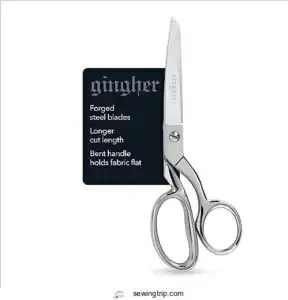
When you’re ready to invest in professional-grade fabric scissors, these Gingher dressmaker shears deliver unmatched quality.
The blade material features forged steel construction that maintains razor-sharp edges through countless projects, while the handle comfort comes from the signature bent design that keeps your hand elevated above the cutting surface.
You’ll appreciate the exceptional cutting performance across multiple fabric layers – from lightweight cotton to heavy denim and wool.
The fabric compatibility extends to virtually any material you’ll encounter in your sewing room, making these versatile sewing scissors a worthwhile investment.
The chrome-over-nickel finish guarantees long-term durability and corrosion resistance.
At 7.2 ounces, they provide perfect balance for precise fabric cutting without causing hand fatigue during extended use sessions.
2. Amazon Basics Multipurpose Stainless Steel Scissors 3 Pack
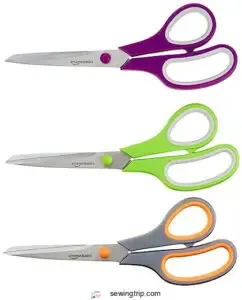
Looking for reliable fabric scissors without the premium price tag? Amazon Basics delivers Amazon Basics Quality through smart engineering and thoughtful design.
This three-pack features stainless steel durability with PVD coating, ensuring blades stay sharp through 100,000+ cuts. The multipurpose use cases extend beyond fabric to paper, cardboard, and photos—making them your go-to cutting tools.
Key advantages include:
- Three-Pack Value provides backup pairs when you need them most
- Soft-grip handles accommodate both left and right-handed sewing scissors users
- User satisfaction ratings consistently praise their reliability and comfort
These scissors types excel as everyday workhorses rather than specialized tools. The scissor features focus on versatility over specialization, while scissor brands like Amazon Basics prove budget options can deliver professional results.
Best for: Sewers wanting dependable, all-around cutting tools that won’t strain your budget.
3. Mazbot 6 Inch Bent Embroidery Scissors
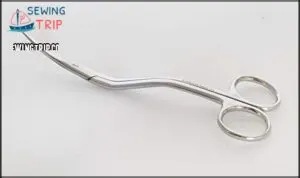
Professional embroidery work demands scissors that can navigate tight spaces with surgical precision. The Mazbot 6 Inch Bent Embroidery Scissors excel where standard fabric scissors fall short.
Precision cutting transforms ordinary embroidery into extraordinary artistry with the right tools.
Their Bent Design creates the perfect angle for working around embroidery hoops without awkward wrist positioning. You’ll appreciate how the curved handles let you maintain natural hand positioning while making precise cuts.
The Blade Sharpness delivers clean thread snips every time, preventing fabric pulls that can ruin delicate work. These embroidery scissors feature razor-sharp edges that maintain their edge through countless projects. For peak performance, remember regular scissor maintenance is key.
The Ergonomic Grip reduces hand fatigue during extended stitching sessions, while the lightweight construction won’t strain your wrist.
Key features that set these sewing tools apart:
- Bent handle design improves hoop clearance and comfort
- Ultra-sharp blades guarantee clean precision cutting
- Adjustable tension screw for customized cutting action
- Chrome-plated finish resists corrosion and wear
- Compact 6-inch size perfect for detailed thread work
Best For: Embroiderers and crafters who need reliable sewing scissors for intricate thread snips and detailed fabric work.
4. Hisuper 45 Inch Sewing Embroidery Scissors with Sheath
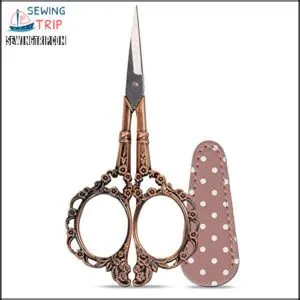
In the context of detailed work, Hisuper 4.5 Inch Sewing Embroidery Scissors with Sheath deliver exceptional Precision Cutting for your Embroidery Projects.
These compact embroidery scissors feature razor-sharp stainless steel blades that slice through threads effortlessly.
The bent handle design promotes natural wrist positioning, reducing hand fatigue during extended crafting sessions.
Hisuper Features include a lightweight construction that fits comfortably in your palm, making them ideal sewing tools for intricate needlework.
What sets these fabric scissors apart is their polka-dot leather sheath.
The Sheath Benefits include blade protection and rust prevention—you won’t accidentally cut yourself while rummaging through your sewing kit.
These scissors often feature high-carbon steel blades for lasting sharpness.
Available in Red Copper or Stainless Steel finishes, these sewing scissors offer professional quality without the premium price tag.
They’re perfect Alternative Scissors for crafters who need reliable performance for detailed embroidery and thread trimming tasks without breaking their budget.
5. Small Sewing Scissors Thread Cutter Snips 3 Pack
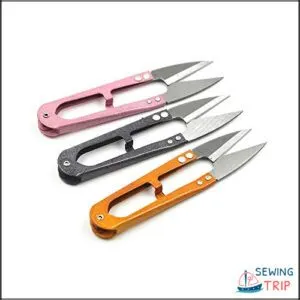
Nothing beats having thread snips within arm’s reach when you’re deep in a sewing project.
The Small Sewing Scissors Thread Cutter Snips 3 Pack delivers exactly that convenience with three compact cutters you can scatter throughout your workspace.
These everyday snips excel at quick thread trimming tasks:
- Clipping embroidery threads without disturbing your work
- Snipping loose threads during garment construction
- Cutting through single strands when precision matters
While the Pack Durability won’t match premium sewing tools, these affordable sewing accessories offer solid Snips Value for basic cutting needs.
The Snips Ergonomics work well for short sessions, and Multi-Pack Uses mean you’ll always have fabric scissors nearby when inspiration strikes your next project.
6. Mr Pen Pinking Shears Zig Zag Fabric Scissors
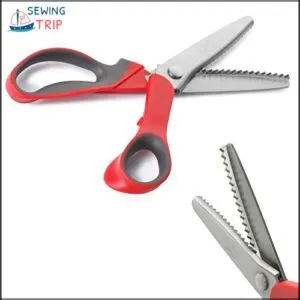
Mr. Pen Pinking Shears create perfect zig-zag angles that’ll make your fabric edges look professionally finished. These sewing scissors excel at fray prevention, keeping cotton, linen, and other woven materials from unraveling after cutting.
The blade sharpness stays consistent over time, unlike cheaper alternatives that dull quickly. You’ll appreciate how the bent handle design keeps your fabric flat during fabric cutting, ensuring clean decorative edges every time.
These pinking shears work across various fabric types and weights, making them versatile for different projects. They might feel stiff initially, but they smooth out with use.
The serrated blades slice through multiple fabric layers while creating those signature zigzag patterns that both prevent fraying and add visual interest. Whether you’re hemming curtains or finishing seam allowances, these fabric scissors deliver reliable performance.
Best For: Sewers wanting dependable fray prevention with decorative flair across multiple types of scissors in their toolkit.
7. Clover Button Hole Cutter Tool
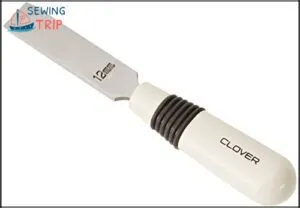
While pinking shears create decorative edges, the Clover Button Hole Cutter Tool tackles one of sewing’s trickiest tasks with precision. This specialized tool transforms buttonhole cutting from guesswork into accurate craftsmanship.
Unlike regular buttonhole scissors, this cutter features an adjustable screw mechanism that controls cutting depth perfectly. You’ll achieve clean cuts without damaging surrounding fabric or threads.
Here are five key benefits of this sewing tool:
- Adjustable Screw Usage – Control cutting depth for different fabric thicknesses
- Tool Safety Features – Protected blade prevents accidental cuts and fabric damage
- Buttonhole Size Guide – Built-in measurements guarantee consistent sizing
- Sharp precision blade – Cuts cleanly through various fabric types
- Ergonomic design – Comfortable grip reduces hand fatigue during use
This cutter works effectively on everything from delicate silk to heavy denim. The lightweight construction makes extended use comfortable, while the razor-sharp blade delivers professional results every time.
Best For: Sewers who want precise, consistent buttonholes without the frustration of traditional fabric scissors or sewing scissors methods.
8. Gingher 6 Inch Applique Scissors for Needlework
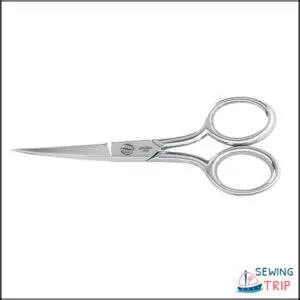
When precision matters most for applique scissors work, you’ll find Gingher Quality shines through in these specialized sewing scissors. The unique Blade Design features a paddle-shaped lower blade that protects your base fabric while trimming excess material close to stitches.
These fabric scissors excel at Applique Precision tasks that challenge regular sewing tools. You’ll navigate tight spaces around applique edges without accidentally cutting through foundation layers. The offset handle design reduces hand strain during extended sewing sessions.
Needlework Uses extend beyond applique work to embroidery, quilting, and detailed fabric crafts. The chrome-over-nickel finish resists corrosion, while the included leather sheath maintains blade sharpness.
While Alternative Brands offer similar tools, Gingher’s reputation for durability sets these scissors apart. You’re investing in precision that lasts through countless projects.
Best For: Quilters, applique artists, and embroiderers requiring surgical precision for delicate fabric work.
9. Handi Quilter Batting Scissors 5 Inch Ergonomic
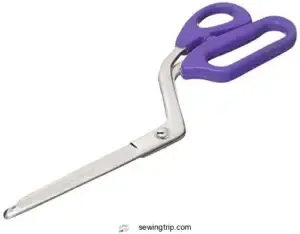
Moving from detailed applique work to quilting projects, Handi Quilter Batting Scissors bring ergonomic design that transforms your quilting experience.
These 5-inch quilting scissors feature rounded tips that won’t catch or tear delicate batting material, while sharp alloy steel blades deliver precise cuts through multiple layers.
The ergonomic design reduces hand strain during extended sewing sessions.
Their blade sharpness handles everything from trimming binding to squaring quilt blocks.
You’ll appreciate how these sewing scissors fit perfectly in your sewing tools collection without crowding your workspace.
Quilting uses for these versatile fabric scissors:
- Clean batting cuts without snagging fibers
- Precise binding and border trimming
- Comfortable grip reduces hand fatigue
- Rounded tips protect delicate quilt layers
Best For: Quilters who need reliable sewing scissors that won’t damage batting while providing comfortable, precise cuts for all quilting uses.
Choosing Fabric Scissors
When selecting fabric scissors, you’ll need to take into account the metal type, your dominant hand, and the tool’s weight for your specific projects.
The handle size and ergonomic design will determine your comfort level during extended cutting sessions.
Scissor Metal Type
When choosing fabric scissors, the construction material determines cutting performance and longevity.
Carbon steel offers superior sharpness and edge retention, while stainless steel provides excellent rust resistance for everyday use.
Metal hardness affects precision—harder steels maintain sharper edges longer but require professional sharpening.
| Material Type | Best For |
|---|---|
| Carbon Steel | Precision cutting, professional use |
| Stainless Steel | General sewing, easy maintenance |
| Titanium-Coated | Lightweight durability, extended use |
Blade durability varies substantially between materials, with high-carbon options lasting longest for serious sewers.
Stainless steel options provide lasting sharpness for a variety of tasks.
Left or Right-Handed Scissors
Your handedness matters more than you think when choosing sewing scissors.
Left handed scissors feature reversed blades that give southpaws proper blade visibility and cutting angle.
Right-handed sewers get cleaner cuts with standard scissors.
Ambidextrous scissors work for both hands but lack ergonomic design, increasing hand fatigue.
Choose fabric scissors matched to your dominant hand for comfortable sewing.
Scissor Weight
Weight affects your cutting comfort and precision more than you might expect. Lightweight scissors prevent cutting fatigue during long sewing sessions, while heavy-duty scissors deliver superior control when slicing through thick fabrics like canvas or leather.
The right scissors transform fabric cutting from a chore into precision craftsmanship.
Your project determines the ideal weight distribution. Fabric scissors with more heft excel at straight cuts through multiple layers, but lighter sewing scissors shine for detailed trimming work.
Consider these weight factors for project suitability:
- Light scissors (under 4 oz) reduce hand strain for intricate work
- Medium weight (4-6 oz) balances control with comfort
- Heavy scissors (over 6 oz) power through tough materials effortlessly
- Weight distribution affects blade stability during cuts
- Heavier tools require stronger storage solutions
Scissor Handle Size and Type
Handle design affects your cutting accuracy and comfort during long sewing sessions. The wrong grip can turn enjoyable projects into hand-cramping ordeals.
Ergonomic Handles with soft curves reduce strain during extended use. Handle Materials like rubber or cushioned plastic provide superior Grip Comfort compared to hard metal or plastic. Handle Length determines leverage—longer handles offer better control for thick fabrics. Ambidextrous Handles work for both hands, though dedicated left-handed sewing scissors perform better for southpaws.
- Ergonomic Handles with finger contours prevent hand fatigue during marathon sewing sessions
- Handle Materials featuring soft-grip coatings reduce slipping and provide cushioned comfort
- Proper scissor handle size should accommodate your finger width without pinching or gaps
- Handle design with thumb rests and balanced weight distribution improves cutting precision
- Quality sewing tools with well-designed handles last longer and perform consistently better
Scissor Maintenance Tips
Proper maintenance keeps your fabric scissors sharp and extends their lifespan substantially. You’ll save money and guarantee clean cuts by following simple cleaning, sharpening, and storage practices.
Cleaning Scissors
Three simple cleaning methods keep your fabric scissors performing flawlessly.
Start by wiping blades with a damp cloth for rust removal, then dry completely.
Apply rubbing alcohol for professional cleaning and disinfection.
Add light blade lubrication near the pivot point using scissor oil.
Clean handles with soapy water for safe handling.
Store scissors maintenance becomes effortless when you protect clean sewing tools in cases between projects.
rubbing alcohol
scissor oil sparingly
protective case
Sharpening Scissors
Through careful maintenance, your fabric scissors can maintain their cutting edge for years.
Sharp sewing scissors make the difference between clean cuts and frayed disasters.
Keep your fabric scissors razor-sharp—dull blades turn precision cutting into a frustrating battle against frayed edges.
Sharpening methods range from simple DIY techniques to professional services:
- DIY sharpening: Cut through folded aluminum foil or fine-grit sandpaper (#180-#220) 10-20 times per blade
- Scissor sharpener tools: Use whetstones or handheld sharpeners, maintaining proper sharpening angles with 10 passes per side
- Professional services: Cost $7-20 but guarantee correct blade alignment and superior scissors maintenance for lasting results
Preventing dullness starts with using your sewing scissors only on fabric—never paper or pins.
Storing Scissors
Proper scissor storage protects your investment and maintains blade sharpness. Choose individual sleeves, hanging solutions, or dedicated storage boxes to prevent blade contact with other sewing tools.
Control humidity in your storage area to prevent rust on fabric scissors. Safe storage means avoiding crowded drawers where blades can nick against other items.
Smart sewing tools storage keeps your scissors ready for precise cuts every time, ensuring complete blade protection and organized multiple-pair storage with options like scissor cases for travel.
Buying Fabric Scissors
When you’re ready to invest in quality fabric scissors, you’ll need to examine three key factors that determine both performance and value.
Smart shoppers evaluate brand reputation, essential features, and price points to find scissors that’ll serve their sewing projects for years to come, considering complete concepts to make an informed decision.
Scissors Brand
Popular brands like Gingher and Kai lead in brand reputation for professional fabric scissors.
Gingher’s high-carbon steel construction guarantees brand durability, while Kai’s Japanese brand origin delivers exceptional sharpness.
Fiskars offers budget-friendly reliability for beginners.
Brand materials vary—stainless steel resists rust, carbon steel stays sharper longer.
These trusted sewing scissors brands guarantee precise cuts for your projects.
Scissors Features
The right features separate quality fabric scissors from disappointing purchases that’ll frustrate your sewing projects.
Blade Material determines longevity—stainless steel resists rust while high-carbon steel maintains Blade Sharpness longer.
Handle Ergonomics become essential during extended cutting sessions, affecting comfort and control.
The Cutting Angle and Pivot Joint quality influence precision, while blade shape affects specific tasks.
Key features for sewing scissors:
- Handle design that fits your grip comfortably without causing fatigue
- Sharp, durable blades made from quality steel that stay sharp
- Smooth pivot action that doesn’t bind or catch during cuts
- Appropriate size matching your intended types of scissors needs
Quality fabric scissors balance sharpness, comfort, and durability for consistent performance.
Scissors Price
Understanding fabric scissors pricing helps you make smart budget considerations for your sewing arsenal.
Entry-level options start around $4-20, while mid-range scissors ($25-50) offer better durability and performance.
Premium models exceeding $50 deliver professional results that last decades.
| Price Range | What You Get |
|---|---|
| Budget ($4-20) | Basic cutting, starter projects |
| Mid-Range ($25-50) | Better steel, improved ergonomics |
| Premium ($50+) | Professional quality, lifetime value |
| Specialty ($80+) | Handcrafted, designer collections |
Brand price points reflect material costs and intended use—you’ll pay more for high-carbon steel versus basic stainless options.
Frequently Asked Questions (FAQs)
What are the different types of fabric scissors?
Think cutting fabric with kitchen scissors is fine? You’ll learn otherwise quickly!
You need dressmaker’s shears for heavy fabrics, embroidery scissors for detail work, pinking shears for preventing fraying, and applique scissors for precision trimming.
Which scissors are best for cutting fabric?
Dressmaker’s shears work best for most fabric cutting – they’re designed specifically for textiles with sharp, angled blades that glide through multiple layers smoothly and accurately.
What is the best pair of fabric scissors?
Like Excalibur waiting for the right hand, quality dressmaker shears prove themselves essential.
They’ll slice through multiple fabric layers cleanly, making precise cuts that cheaper scissors simply can’t match.
You’ll want 8-10 inch high-carbon steel blades with ergonomic handles.
What is the difference between Gingher and Fiskars scissors?
Gingher scissors feature forged steel construction and precision-ground blades, making them pricier but longer-lasting. Fiskars offers lightweight, ergonomic designs with comfort grips at budget-friendly prices, though they’re less durable.
What is the difference between Gingher and Fiskars fabric scissors?
Gingher scissors feature premium steel construction and precise hand-finishing, making them sharper and longer-lasting but pricier. Fiskars offers ergonomic designs with comfortable handles at budget-friendly prices, though they’re less durable.
What are the best scissors for cutting multiple layers of fabric?
Heavy-duty shears work best for multiple fabric layers. You’ll want dressmaker’s shears with long, sharp blades and comfortable handles that provide leverage for clean cuts through thick stacks.
What type of scissors are best for fabric?
You’ll want dressmaker’s shears for most fabric cutting—they’re designed specifically for textiles with sharp, long blades.
For precision work, grab embroidery scissors, and use pinking shears to prevent fraying edges.
What is the difference between shears and scissors for fabric?
Picture yourself reaching for cutting tools—here’s the key difference: shears exceed six inches with asymmetrical handles for leverage, while scissors stay under six inches with symmetrical finger holes.
Making shears ideal for heavy fabrics.
What type of scissors keep fabric from fraying?
Pinking shears are your go-to scissors for preventing fabric fraying.
Their distinctive zigzag-edged blades cut a sawtooth pattern that stops threads from unraveling, making them essential for finishing raw edges professionally.
What scissors are best for cutting lace?
Delicate lace transforms into shredding nightmares with wrong scissors.
You’ll need embroidery scissors with razor-sharp, fine-pointed blades for precision cutting.
Their small size and curved design navigate lace’s intricate patterns perfectly without snagging threads, making them ideal for delicate work with razor-sharp blades.
Conclusion
Master craftsmen throughout history understood that the right tool transforms good work into greatness.
Your journey with the various types of fabric scissors for sewing follows this same principle.
From delicate embroidery scissors for intricate details to heavy-duty tailor’s shears for thick fabrics, each tool serves its purpose.
You’ll save time, protect your materials, and achieve professional results when you match the scissor to the task.
Start with quality dressmaker’s shears, then build your collection as your skills grow, using the various types of scissors appropriately.
- https://www.diamondneedle.com/fabric-scissors-vs-regular-scissors
- https://www.picolly.com/how-to-choose-tailors-scissors-cutting-tools
- https://ribbonbazaar.com/ribbon-bazaar-fabric-and-tailor-scissors/p/z3tQ8rfyxg6DfP4MHVpJn
- https://creativerehab.co.uk/understanding-different-types-of-sewing-scissors/
- https://lacreativemama.com/best-sewing-scissors/

